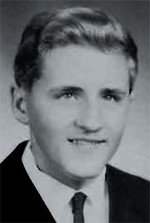Clipper Chatter
| Forum: Member Stories | |||||
|
|||||
|
Christopher Newman
 Posts: 28 View Profile |
"Storytelling" ...On East Baltimore Street Posted Sunday, November 18, 2012 02:34 PM When I was very young and very little, one of my most endearing memories of my young mother (*see bottom of page) was the storytelling time we spent together before bedtime. She would put me on her lap, under a standing lamp in Grandmother Newman's front parlour, and open a pen and ink illustrated book filled with fairy tales and various children's stories written by Hans Christian Anderson, Lewis Carroll, the Grimm Brothers, C. S. Forester and others. I would soon get lost in the wonderful stories mother read to me, imagining exciting action plots, people flying like birds, talking animals, and magic ... and making new friends like: Hans Brinker, Brer Rabbit, Flicka, Alice, Peter Pan, Tom Sawyer and dozens of others. This was such a loving and magical time for me - which I know helped to develop my imagination, creativity, intellect and a desire to read books. During the 1940's, the radio became the storyteller. We (my mother and grandmother, my sister, myself, and sometimes my father, a cousin, Carolina or Theresa, or a neighbor) would gather around the decorative fireplace mantle, in the parlour, usually after sunset. During the winter months the room was darkened except for an electric heater, which sat in front of the mantle, casting an eerie soft light on the room. It was in this "perfect storytelling environment" that we listened to popular radio programs like: The Shadow (my favorite), Gang Busters, Fibber McGee and Molly, Amos and Andy, The Fat Man, The Green Hornet, Burns and Allen, etc. We listened intently and through the words, sound effects, and music we imagined and created visually, in our minds, the stories that were told. In the 3200 block of East Baltimore Street, where I lived until the third grade, we had our own storyteller. "Theda" was probably about thirteen or fourteen; she loved little children and of course we adored her. Theda was obviously bright and creative ... and a great storyteller. She had a following of 5 or 6 children and whenever we could, we sat down with Theda in someone's backyard where she proceeded to tell us the most amazing tales. Theda had a good memory for storytelling or she may have made up the characters and plots as she went along. I remember her and those good times spent in the backyards and alley behind my grandmother's house. There were other storytellers in the family, older cousins and my father. My father was so effective that he had all of us believing in "leprechauns" -- and seeing them in the apple tree, usually in mid-March, around Saint Patrick's Day. While in school my favorite teachers were also storytellers. They could cleverly weave the subject that they were teaching with a great story. At Patterson there was Mrs. Baldwin, Mrs. Tillery, Mr. Stein, Mr. Ercole and most of my English teachers. Sister Margaret Saint Francis, O.S.F., at the Shrine of the Little Flower School, was very skilled at storytelling. She so lovingly mixed the Words of Jesus, the lives of the Saints, sometimes poetry and art into one great story - day after day - to her class of 75 fouth grade students. (No teacher aides or Ritalin for the boys - in those days, just one nun and a class of 70 to 80 children!). Storytelling is "basic training" for academic learning. When children listen to stories, invent their own or see images in a book, they learn to associate between story and images, and later imagination and visuals. A good storyteller involves the listener by asking questions or encouraging the listener to be curious and also ask questions. A proper narration can be a bit theatrical -- using gestures, eye-movement and verbal sounds to emphasize important portions of the story. I have found that a quiet, darkened room is the best environment to tell a story. The most significant benefit of storytelling is: increased knowledge in children -- learning new vocabulary, enhancing listening, visual and verbal skills, and developing creativity and a desire to read. Sadly, today, storytelling is becoming a lost art. I also see reading and physical activity (for children) being replaced by television, computer games, handheld computer gadgets, and cellphones. When I was a boy, growing up in Baltimore, it was quite normal to see two boys throwing a baseball back and forth - for hours, or a lacrosse ball, or playing tennis, riding bicycles, or just taking a long exploratory walk in a park or through the city streets. During this past summer and early fall, I intentionally looked for children playing outside ... the streets, the playgrounds, the parks, and the backyards were, to a large extent, absent of children. I can only speculate that many children were inside, in air-conditioned houses, playing computer games , many excessively violent (like the grotesque "Kindergarten Killers"), watching television, texting their friends or talking on their cellphones. I don't think this is healthy. In this day and age many people think that it is essential that children know how to use a computer. But if this is true, isn't it also essential that children learn to use a computer, or computer games and gadgets -- responsibly and within limits -- placed upon them by involved parents? Have you ever been with a child or adolescent (even an adult) who is so totally engaged with a computer gadget, computer game, television program, or texting - that it is impossible to converse with them? Interaction with a game, rather than a human being is apparently preferred ... and "Life" becomes just a part of a game. Christopher Wm. Newman, November 18, 2012 * My mother, Margaret Elizabeth Newman (Isabelle), passed away on June 22, 2012. In her 92 years she never lost her joy or her friendliness and generosity toward everyone: relative, friend or stranger. She lived with me, here on the Eastern Shore, for the past 15 years. She was my best friend ... "she was a storyteller."
|
||||
|
|||||

